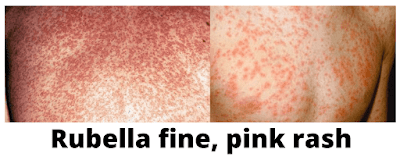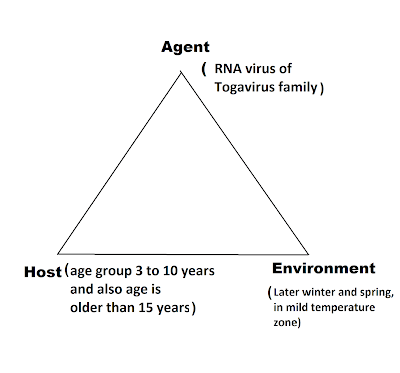Rubella (German Measles)
Rubella is a contagious viral infection caused by caused by
rubella virus that occurs most often in children and young adults. Rubella
infection is preventable by vaccine.
Rubella is also called germen measles. Rubella is a disease which have teratogenic (cause abnormal fetal development) affect. It is an acute childhood infection.

Epidemiological Triad

Agent – Rubella disease is caused by caused by rubella virus, RNA virus
of Togavirus family. This virus is present in the nasopharynx, throat, CSF,
blood and urine of a case of rubella.
Host – Rubella occurs in children in the age group 3 to 10 years.
In developed countries - age is older than 15 years
Environmental factors - It occurs during later winter and spring, in
temperate (mild temperature) zone.
Mode of Transmission
Portal of entry – Respiratory route
1. Droplets form nose, throat
2. Droplet nuclei
3. By Infected person coughs or sneezes
4. By direct contact with an infected
individual’s respiratory secretions, mucus.
5. Rubella virus can cross placenta, Spread
from pregnant women to their unborn children via the bloodstream.
Rubella virus can cross placenta and can
cause congenital rubella in new born.
Incubation Period
Average incubation period is 17 days (with a
range of 12 to 32 days).
An individual who has been infected with the
rubella virus that causes rubella is contagious for 1 to 2 weeks before the
onset of the rash and then rash starts on the face and spreads to the rest of
the body.
Pathophysiology of Rubella
1. The infection is transmitted via direct or
droplet contact with respiratory secretions.
2. Infects cells in the Upper respiratory tract
2. Rubella virus multiplies in cells of the
respiratory system nasopharynx
3. Viremic spread to target organs, spread
to cervical lymphnodes.
4. Rashes and lesion on skin, cough, sore
throat, joint pain developed
Congenial Rubella Syndrome (CRS)
1. Rubella virus infection early week of
pregnancy by respiratory route.
2. Maternal viremia - Abortion
3. Placental infection – cross the placenta and
cause fetal damage
a. Mitotic inhibition – apoptosis
Destruction of the ocular lens
Growth retardation
Bone lesion
b. Damage to vascular endothelium
Encephalitis
Mental retardation
Deafness
Clinical Features of Rubella
1. Post Natal Rubella - Occurs in Neonates and childhood
2. Congenital Rubella - results from maternal infection with rubella virus during pregnancy that infant’s infection.
Signs or Symptoms of Rubella
1. Coryza (Stuffy or runny nose), sore throat,
low grade fever as prodormal symptoms.
2. Enlargement of post- Auricular and posterior
cervical lymph nodes (found in the neck)
3. Rash which appears first on the face usually
within the onset of prodormal symptoms. Minute and pinkish, macular rashes are
appeared.
4. Conjunctivitis (Inflamed red eyes) can
occur
5. Aching joints
Lab Investigation
1. Throat swabs sample
2. Serological test -
Hemagglutination-inhibition test (HI)
3. ELISA test
4. Radioimmunoassay test
Treatment of Rubella
There is no specific medicine to treat rubella
infection but the disease is preventable by vaccination and can treat specific
symptoms of the disease.
Medicines for fever, such as Acetaminophen
Prevention and Control
1. Live attenuated vaccines- Against rubella disease, vaccination is
given in combined form as MMR.
MMR vaccine - protects against measles, mumps
and rubella infection.
MMR-V vaccine - protects against rubella,
measles, mumps, and chickenpox
Vaccine
Dose
Route
RA
27/3
0.5ml
subcutaneously
(Live attenuated)
Reaction - Mild reaction such as malaise, mild fever, mild
rash and arthralgia; pain in a joint
Person who receive MMR vaccination according to vaccination
schedule are usually considered protected for against measles and rubella diseases.
Note - Pregnant women should NOT given MMR vaccine. If
rubella or are exposed to rubella during pregnancy, contact doctor
immediately.
2. Immunization
3. Isolation
4. Early diagnosis
Complications of Rubella
1. Arthralgia (pain in a joint)
2. Thrombocytopenic purpura (decrease in the
number of platelets in the blood)
3. Encephalitis
Pregnancy and Rubella
Rubella is very dangerous infection for a
pregnant woman and her developing baby.
Rubella virus can cross the placenta barrier and
causes intra uterine infection and damge the fetus. Rubella infection inhibits
cell division.
Rubella infection can cause a miscarriage or
serious birth defects in a fetus, if woman is infected during pregnant. The
best protection against rubella disease is MMR (measles, mumps, rubella)
vaccine.
Up to 80% of infants born to mothers who had
rubella during the first 12 weeks of pregnancy develop congenital rubella
syndrome and CRS) and Birth Defects. This syndrome can cause one or more
problems, including:
1. Growth delays - Mental retardation,
Motor retardation
2. Cataracts
3. Deafness
4. Congenital heart defects
5. Defects in other organs
6. Intellectual disabilities
7. Skin rash at birth
8. Liver and spleen damage
9. Low birth weight
10. Microcephalus
(head is smaller than normal)
11. Cerebral palsy ( disability to move and
maintain balance and posture
The highest risk to the fetus is during
pregnancy of the first trimester, but exposure later in pregnancy is dangerous.
Measles and Rubella Initiative
The measles and rubella initiative (M and R
initiative) launched in 2001, with global partnership led by the American Red
Cross, United Nations Foundation, Centres for Disease Control and Prevention
(CDC), UNICEF and WHO.
The aim of this initiative is to ensuring that
no child dies from measles or is born with congenital rubella syndrome
(CRS).
Rubella FAQ
1. What is congenital rubella syndrome?
Congenital rubella
syndrome (CRS) is a disease in infants that results from maternal infection during
pregnancy infected with rubella virus. CRS
occurs in a developing baby in the mother womb whose mother is infected with
the rubella virus during pregnancy.
When mother infected
with rubella infection during early pregnancy, especially
during the first trimester, it causes serious consequences such as miscarriages,
stillbirths, fetal death, severe birth
defects in infants such as infants with
congenital malformations, known as congenital rubella syndrome (CRS).
2.
Can rubella cross the placental barrier?
Rubella virus
can cross the placenta barrier from an infected pregnant woman to her
developing embryo or fetus.
3. How rubella is diagnosed?
If have appearance
of rubella rash, Rubella infection is diagnosed by a blood test or virus
culture, enzyme-linked immunosorbent assay (ELISA, EIA).
4. What is
MMR vaccine?
The full
form of MMR is Measles, Mumps, and Rubella. MMR vaccine is a vaccine that
protects against measles, mumps, and rubella (German measles).







0 Comments